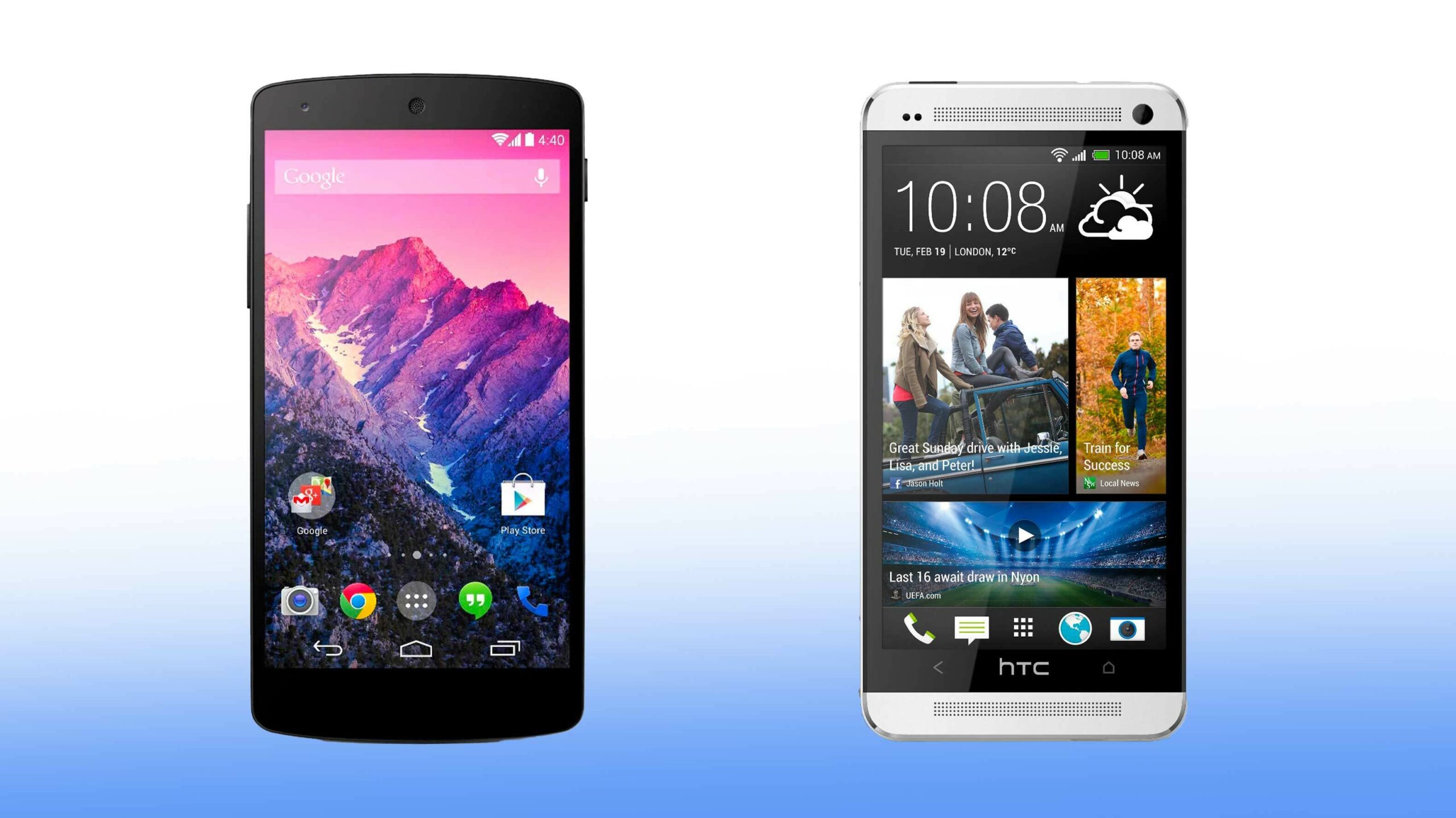
Almost 10 years ago, HTC and LG were leaders in the smartphone market and for both of those companies, 2013 was a very important year.
What I’m talking about is more important than most of the other events that happened that year, including the birth of Prince George, the launch of The Last of Us and Lady Gaga’s return to the spotlight — the release of the HTC One M7 and Google’s Nexus 5.
A while back we asked what your favourite phones were, and many of you chose the HTC One M7 and Nexus 5. With that in mind, let’s take a step back in time and remember these smartphone titans that had us Android nerds giddy with joy. In 2013, I went out and bought an HTC One, so I have fond memories of that device, but I also used to work at Best Buy and was envious of the Nexus 5 owners. I played with Google’s device whenever I got the chance.
This is all based on tech specs, our previews/reviews of the two smartphones and, of course, my own personal opinion. We encourage you to share your thoughts on this nostalgic look back at the two iconic phones below:
HTC One (M7)
LG Nexus 5
Display
4.7-inch Super LCD3, 1080 x 1920-pixel resolution
4.95-inch True HD IPS+, 1080 x 1920-pixel resolution,
Processor
Snapdragon 600
Snapdragon 800
RAM
2GB GB of RAM
2GB GB of RAM
Storage
32GB, 64GB
16GB, 32GB
Dimensions (in.)
137.4 x 68.2 x 9.3 mm
137.9 x 69.2 x 8.6 mm
Weight
143g
130g
Rear Facing Camera
4-megapixel (f/2.0 aperture + ultrapixel)
8-megapixel (f/2.4)
Front Facing Camera
2.1-megapixel
1.3-megapixel
OS
Android 4.1.2 (Jelly Bean) upgradable to Android 5.0 (Lollipop), Sense UI 5
Android 4.4 (Ice Cream Sandwich) upgradable to Android 6.0 (Marshmallow)
Battery
2,300mAh battery
2,300mAh battery
Network Connectivity
GSM / HSPA / LTE
GSM / HSPA / LTE
Sensors
Accelerometer, gyro, proximity, compass
Accelerometer, gyro, proximity, compass
SIM Type
Micro SIM
Micro SIM
Launch Date
March 1, 2013
November 1, 2022
Misc
Colours: Black, Silver, Red, Blue, Gold | Infrared
Colours: Black, White, Red
Display
HTC One (M7)
4.7-inch Super LCD3, 1080 x 1920-pixel resolution
LG Nexus 5
4.95-inch True HD IPS+, 1080 x 1920-pixel resolution,
Processor
HTC One (M7)
Snapdragon 600
LG Nexus 5
Snapdragon 800
RAM
HTC One (M7)
2GB GB of RAM
LG Nexus 5
2GB GB of RAM
Storage
HTC One (M7)
32GB, 64GB
LG Nexus 5
16GB, 32GB
Dimensions (in.)
HTC One (M7)
137.4 x 68.2 x 9.3 mm
LG Nexus 5
137.9 x 69.2 x 8.6 mm
Weight
HTC One (M7)
143g
LG Nexus 5
130g
Rear Facing Camera
HTC One (M7)
4-megapixel (f/2.0 aperture + ultrapixel)
LG Nexus 5
8-megapixel (f/2.4)
Front Facing Camera
HTC One (M7)
2.1-megapixel
LG Nexus 5
1.3-megapixel
OS
HTC One (M7)
Android 4.1.2 (Jelly Bean) upgradable to Android 5.0 (Lollipop), Sense UI 5
LG Nexus 5
Android 4.4 (Ice Cream Sandwich) upgradable to Android 6.0 (Marshmallow)
Battery
HTC One (M7)
2,300mAh battery
LG Nexus 5
2,300mAh battery
Network Connectivity
HTC One (M7)
GSM / HSPA / LTE
LG Nexus 5
GSM / HSPA / LTE
Sensors
HTC One (M7)
Accelerometer, gyro, proximity, compass
LG Nexus 5
Accelerometer, gyro, proximity, compass
SIM Type
HTC One (M7)
Micro SIM
LG Nexus 5
Micro SIM
Launch Date
HTC One (M7)
March 1, 2013
LG Nexus 5
November 1, 2022
Misc
HTC One (M7)
Colours: Black, Silver, Red, Blue, Gold | Infrared
LG Nexus 5
Colours: Black, White, Red
Round One
In the first round, we’ll talk about body and display.
The HTC One M7 featured a 4.7-inch display that was slightly smaller than the Nexus 5’s 4.95-inch screen. Both offer a 1080 x 1920 pixel resolution, which means the One M7 features a better pixel density, but the Nexus 5 had a bigger panel.
The One M7 was heavier than the Nexus 5, weighing in at 143g compared to the Nexus 5’s 130g. The weight was due to the HTC One’s aluminum back and frame, which was heavier than the plastic back and frame of the Nexus 5. HTC’s device was also slightly thicker than the Nexus 5.
I found that the HTC One M7 felt more solid in my hand due to the aluminum frame, which might be why many modern devices still feature aluminum frames. However, that’s not to say the Nexus 5 wasn’t an incredibly solid device. Back in 2013, former MobileSyrup managing editor Daniel Bader said that Google’s smartphone felt “extremely solid.” This was primarily because of the phone’s rubbery rear material, according to Bader’s reporting.
Because HTC’s smartphone featured two speakers flanking the display, smartly utilizing the device’s bezel space, it looked better than the Nexus 5. I also just loved that metal body.
Winner: HTC One M7
Round Two
In this round, we’ll talk about both devices’ processors.
HTC’s One M7 featured Android 4.1.2 as a base for HTC’s Sense UI 5. In those days, Android skins offered a clunky experience that sometimes added additional lag to the phone’s experience. HTC Sense UI 5 was definitely better than what was available with competitors like Samsung’s TouchWiz, LG’s Optimus UI and Sony’s Xperia UI. But nothing could beat stock Android. Don’t get me wrong, I like HTC’s Sense UI 5, which offered a minimalistic design, a scrolling news aggregator called BlinkFeed and more. However, at the top of the user experience was Nexus’ stock Android.
HTC’s One M7 features a Qualcomm Snapdragon 600 processor, compared to Nexus’s Snapdragon 800-series processor. Qualcomm’s 600 processor was designed for high-tier devices and improved battery life, but the Snapdragon 800 processor offered superior processing and was for premium-tier phones.
Both devices featured 2GB of RAM, but the Nexus 5 offered a stock Android experience that used less RAM than Sense UI 5. However, the One M7 sported up to 64GB of storage, and the Nexus 5 only had up to 32GB of storage. Neither of these devices had expandable storage.
Winner: Nexus 5
Round Three
This round is all about the camera.
On paper, the Nexus 5 should win this bout; however, HTC also had some tricks up its sleeve. The HTC One M7 offered a 4-megapixel camera, but it also boasted HTC’s “Ultrapixel” technology, something that phones still implement today. The phone featured larger two micro pixels on its sensor, compared to the 1.1 microns of most phones of that era, allowing 300 percent more light to enter its sensor. The technology led to brighter pictures in non-optimal lighting situations. This resulted in Bader writing that “this is the best low-light camera you can buy.” The One M7’s pictures were sharp, detailed, and offered a lot of light.
Here’s a personal anecdote: back in 2013 I took plenty of photos at a darkly-lit event with my HTC One and the images ended up looking better than those snapped by a photographer with a DSLR.
HTC also offered its Zoe feature (Zoetrope), which shot a burst of photos that came to life in a short GIF-like video, similar to Apple’s ‘Live Photo’ technology that released several years later. The HTC One’s optical stabilization also helped prevent photos from becoming blurry.
The Nexus 5, on the other hand, featured an 8-megapixel sensor with 1.9-micron pixels. However, according to our review of the device, the Nexus 5 was unreliable. Bader explicitly mentions that the low-light images paled in comparison to the HTC One M7’s.
Winner: HTC One M7
HTC’s One M7 also had better battery life than the Nexus 5, with Google’s device dying around dinner time, while the HTC One would last all day. Additionally, the One M7 featured excellent Beats by Dre stereo speakers. That said, the Nexus 5 was $200 more affordable than the $630 HTC One.
Overall, I’d say the HTC One is the winner.
Why does this matter? It doesn’t, but it’s fun to compare two competing devices released nine years ago. It’s also interesting that several of the HTC One M7’s key features are still available in modern smartphones.
Here are our original (ancient) reviews of the HTC One M7 and the Nexus 5.
Let us know in the comments below which of these smartphone titans you preferred.
MobileSyrup may earn a commission from purchases made via our links, which helps fund the journalism we provide free on our website. These links do not influence our editorial content. Support us here.


